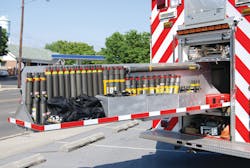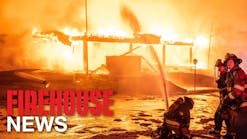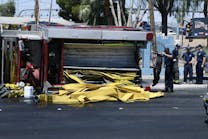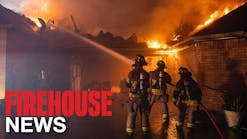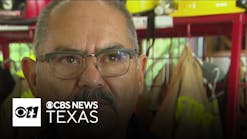Technical rescue teams are being placed into service in many fire departments to expand the capabilities of fire-rescue and medical response to include confined-space rescue, high-angle rescue, trench rescue, swiftwater rescue, structural collapse, damage assessment and as well as weapons of mass destruction (WMD) preparedness. Each area requires specialized expertise gained through extensive training in different scenarios as well as thorough knowledge of the tools and equipment required to safely and effectively carry out these missions. The scope of technical rescue is ever changing and as a result new equipment and technologies are being rapidly developed to keep pace with the increased demands on this service.
In The Apparatus Architect series, we have previously discussed several aspects relating to rescue squad apparatus design in parts 23 through 26, where one overriding principle is to determine the overall mission of the unit before setting out to specify a new rescue vehicle. There are some parallels going back into history with the development of rescue company apparatus and the present-day expansion into technical rescue services.
At the outset, many larger departments, including the New York City Fire Department, placed rescue company units into service with older apparatus that were rebuilt to meet their needs. Rescue Company 1 in New York, which was organized in March 1915, first operated with a 1914 Cadillac touring car that was modified by the department shops. Three different versions of these open-bodied apparatus were used until the first custom-built, fully enclosed walk-in rescue was placed into service with Rescue Company 1 in 1939.
So what is the parallel here with respect to technical rescue apparatus? Even before the current economic downturn, fire departments were being called on to provide more services to the community with stagnant or reduced funding levels. Placing a technical rescue team into service requires a good amount of funding to provide the necessary staffing, training and equipment to support the mission of the team and to meet the needs of the department. The type, size and quality of the vehicle used to transport personnel and equipment can vary widely, based on the financial resources available and the internal resources of the department.
Technical rescue units fall under the category of Special Service Fire Apparatus in the National Fire Protection Association (NFPA) 1901 Standard for Automotive Fire Apparatus. Depending on the gross vehicle weight rating (GVWR), the minimum equipment allowance could be a little as 2,000 pounds for units up to 15,000 pounds GVWR up to 10,000 pounds for trucks with a GVWR of 60,001 pounds or more. Determining the needed size of your technical rescue apparatus depends on many factors, such as:
- Will the apparatus be staffed on a daily basis and respond to routine emergencies as well as incidents requiring technical rescue expertise?
- What is the anticipated equipment inventory, including the size and weight of each piece of equipment?
- Will this vehicle be a stand-alone unit or will it operate with other support apparatus and companies when needed?
- Considering the assessment of these questions, will the overall needs of the vehicle be best met by using a commercial Class 7 or 8 chassis or a custom-built fire chassis?
- Given the equipment payload and staffing levels, will a walk-in-style rescue body or walk-around, fully compartmented body best meet the needs of the team?
Selecting a Chassis
These are just some of the areas that need to be explored before setting out to develop a set of specifications for a new piece of apparatus. In Part 26 of The Apparatus Architect (Firehouse®, April 2006), we compared some of the differences in chassis components and available options between commercial and custom fire chassis. Commercial chassis offer a wide range of options for wheelbase and axle capacities and can save significant money over their custom-chassis counterparts, particularly if the technical rescue unit is going to be primarily used as a support vehicle and the need to carry personnel inside of the cab is limited to four personnel or less.
Custom chassis can generally provide a wider range of cab options, including extended cabs with different seating arrangements to accommodate just about any configuration. Other safety-related equipment such as electronic stability controls, vehicle data recorders and airbags will be more readily available on custom chassis. All of these components and options come at a price, so your department's apparatus committee must be sensitive to meeting the needs and objectives of the apparatus while paying attention to the overall budget for the project.
One of the most important tasks is to not only clearly define the mission of the apparatus, but to develop a comprehensive list of equipment that the technical rescue vehicle will carry. Each piece of equipment should be noted with its principal dimensions and weight. While some pieces of equipment such as tripods and rappelling gear do not weigh a great deal, the size of these pieces can be critical when determining appropriate compartment dimensions and modules to hold this gear within the body. Likewise, pieces of timber and shoring material can add significant weight to the equipment payload. Fixed body components such as generators, air compressors, light towers and breathing air systems must be considered when determining an appropriate-size chassis and components to safely handle the anticipated payload.
Once the initial body dimensional design is completed, there should be sufficient room in the body and axle capacity on the chassis to accommodate future growth as new equipment is acquired. It is not surprising that most rescue squad apparatus are replaced when there is insufficient compartment space to carry the needed equipment; at times, smaller units can easily become overloaded as heavier equipment is needed.
Many technical rescue teams started with a hand-me-down vehicle or one that was modified to meet its initial needs, so the deficiencies of these units were generally quickly identified with improvements made in subsequent newer apparatus. A common mistake is to design the new vehicle to meet the current requirements without looking far enough into the future to anticipate changes in equipment and technological advances which can impact procedures and operations. As a minimum, approximately 15% to 20% of the cube of the body should be left open and available for future equipment expansion and changes.
Weighing Options
As with many specialized vehicles, there can be a lot of opinions as to how the apparatus should be set up, deployed and used to its best advantage. Again, history can guide us here, as very few departments get everything right the first time they set out to design a complex rescue apparatus from scratch. At times, one of the other downfalls of larger rescue vehicles is that the committee will set out to acquire the largest piece of apparatus that will fit the firehouse or the budget, figuring that the details of equipment placement, side-to-side weight balance and component compatibility will all just magically work themselves out. Simply put, your committee should expect a few hurdles during the initial discussions and design of the vehicle. Seek out the advice of departments that are operating in a similar fashion to gain from their experience and from apparatus builders that specialize in constructing these types of vehicles.
Most manufacturers can take your tool and equipment inventory and with the use of computer-aided design (CAD) drawings develop a blueprint that depicts equipment locations showing all of the principal dimensions, including areas that would be available for expansion. If your team started operations with an older vehicle, the experience gained from using this unit can assist in providing information as to what worked well and, more importantly, what did not. There should be no shame in making mistakes so long as the learning curve is lessened in the future. The safety of our operating personnel should always be at the forefront of any discussions with respect to the apparatus as well as the placement and use of the equipment carried. Training, experience and a review of lessons learned will improve the skills and safety for everyone operating with these specialized tools and equipment.
TOM SHAND, a Firehouse® contributing editor, is a 36-year veteran of the fire service and works with Michael Wilbur at Emergency Vehicle Response, consulting on a variety of fire apparatus and fire department master-planning issues. MICHAEL WILBUR, a Firehouse® contributing editor, is a lieutenant in the New York City Fire Department, assigned to Ladder Company 27 in the Bronx, and has served on the FDNY Apparatus Purchasing Committee. He consults on a variety of apparatus-related issues around the country. For further information, access his website at www.emergencyvehicleresponse.com.
